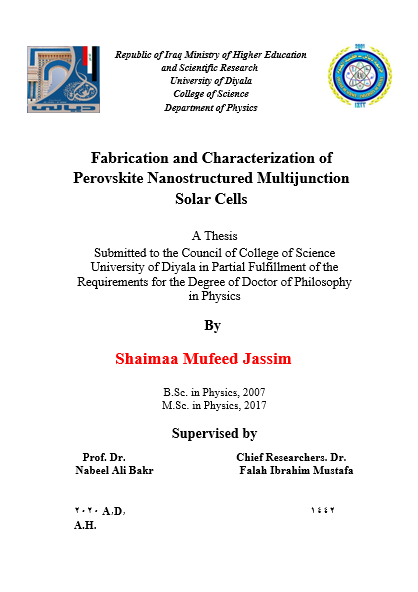Abstract
Perovskite and Multijunction solar cells are a third generation type of solar cells. Their working principle is based on the conversion of sunlight into electrical energy.
In this study, firstly three types of methyl ammonium halide nanopowders MAX (X = halide= I, Br, and Cl) have been synthesized by using chemical bath method. After that, eight different types of organic-inorganic perovskite thin films have been prepared by using spin coating technique which is (MAPbI3, MAPbBr3, MAPbCl3, MAPbICl2, MAPbIBr2, FAPbI3, CsPbI3 and MASnCl3). In addition, eight single inverted planar perovskite solar cells (SIPPSCs) and multijunction inverted solar cells (MJISCs (c-Si and SIPPSCs)) have been fabricated successfully by using the prepared different perovskite films as a sensitized absorption layer (active layer).
The structure of SIPPSC consisted of (fluorine tin oxide (FTO) substrate/ Poly (3,4-ethylenedioxythiophene) polystyrene sulfonate (PEDOT:PSS)/ Perovskite/ [6,6]-Phenyl C71 butyric acid methyl ester (PC71BM)/ Aluminum (Al)). In beginning, PEDOT: PSS layer was deposited on FTO coated glass substrate by spin coating technique which acts as hole transport layer (HTL). The different types of perovskite material that act as an absorbing layer were deposited on PEDOT: PSS layer also by spin coating technique. Then, PC71BM layer which represents the electron transport layer (ETL) was deposited on perovskite layer by spin coating technique. Finally, Al as a metal layer was deposited on PC71BM film by thermal evaporation technique, to get cathode electrode.
MJISC structure consisted of (Al/ crystal-silicon (c-Si)/ tin oxide (SnO2)/ PC71BM/ Perovskite/ PEDOT: PSS/ FTO). For the fabrication of MJISCs, initially the SnO2 as a transparent layer was deposited on the c-Si solar cell by using thermal evaporation technique. Then (Al) was deposited as a conductive electrode on the back face of the silicon cell also by using thermal evaporation technology. Finally, the single inverted perovskite solar cell without Al layer was stacked on c-Si solar cell with SnO2 film by using simple mechanical method.
The structural and morphological properties of prepared powders, different perovskite thin films and SnO2 film have been investigated by X-ray diffraction (XRD) and field emission scanning electron microscope (FESEM) techniques respectively. The optical properties (absorbance and energy gap) of different perovskite films, SnO2 and PEDOT: PSS films have been investigated by (UV-Vis) spectrophotometer. While, photovoltaic characterizations of the fabricated IPPSCs and MJISCs based on different perovskite films have been measured by solar cell simulator.
The XRD results showed that all powders and SnO2 film were polycrystalline with tetragonal structure. All the perovskite films were polycrystalline with different structures which are (tetragonal MAPbI3, cubic (MAPbBr3, MAPbCl3, MAPbICl2 and MAPbIBr2), rhombohedral FAPbI3, orthorhombic CsPbI3 and triclinic MASnCl3).
The FESEM images showed that the powders possess nanonails at (X= I) and nanospheres at (X= Br and Cl) like shapes. While, the perovskite films possess different shapes and SnO2 film has cauliflower like shapes.
The results of UV-Vis spectra showed that all perovskite films have a good absorbance in visible and near IR region. Consequently, it was chosen as an active absorption layer in applications of solar cell.
The optical energy gap for allowed direct electronic transition was calculated using Tauc’s model and it was found that the values of energy gap of all perovskite films vary with different variables.
The photo current density-voltage (J-V) curve characteristics of fabricated solar cells have been measured under simulated solar light (100 mW/cm2). On the other hand, the parameters (including Voc, JSC, FF and efficiency) of solar cells were calculated depending on J-V curve.
The results showed that the fabricated SIPPSCs and MJISCs based on perovskite (methylammonium lead iodide (MAPbI3) layer as an active layer recorded higher efficiency of (10% and 12.8%) compared to the other fabricated solar cells.




